Automotive Pages
- 1962 Oldsmobile
- 1956 Ford Pickup
- 1970 Ford Maverick
- 1959 Volvo PV544
- 1973 Honda Civic
- 1972 Ford Pickup
- 1983 Volvo 240
- 1999 GMC Suburban
- 1965 Triumph TR4
- 2007 Ford Focus
- 2024 Tesla Model Y
Motorcycle Pages
Other Automotive Links
1976 Honda CB750 - Trip I
 The Cross Country Trip of 1979
The Cross Country Trip of 1979
In the spring of 1979 I was in my last semester of a two-year mechanical drafting program at Long Beach City College, getting fed up with my job at the photolab, and reading "Zen and the Art of Motorcycle Maintenance" by Robert Pirsig. "Zen and the Art" as we called it, rekindled a longtime fascination with taking a long motorcycle trip that was sparked many years earlier by the 1969-1970 television show "Then Came Bronson." The show starred Michael Parks as a guy who roamed the country on his motorcycle, moving from one narrative drama to the next. And then there was Peter Fonda and "Easy Rider," another Sixties influence.
Back then, my friends and I talked about getting on our motorcycles and hitting the road in similar fashion. How cool would it be to do something like that? At the time, none of us had the time or the resources to just "take off" and wander around the country. For myself, I had a job, school, a girlfriend, and the looming military draft. My friends had their own collection of distractions so this all just became a topic of dreams rather than a possible realization. Then in 1972 I responded to the military draft and my bike was sold and I longed to become a civilian again, getting another motorcycle, and trying to achieve this goal.
Reading "Zen and the Art" created a serious itch to hit the road. I had a capable motorcycle. My friends had scattered or had responsibilities that prevented them from taking much time off, but I wasn't going to let that deter me. I quit my job in May about the same time as my classes completed and I started the planning phase. The initial work was to get the bike ready, so a fair amount of effort was put into that. A few weeks before the trip, my friend, Steve, and I took our bikes over to El Dorado Park for a photo session:
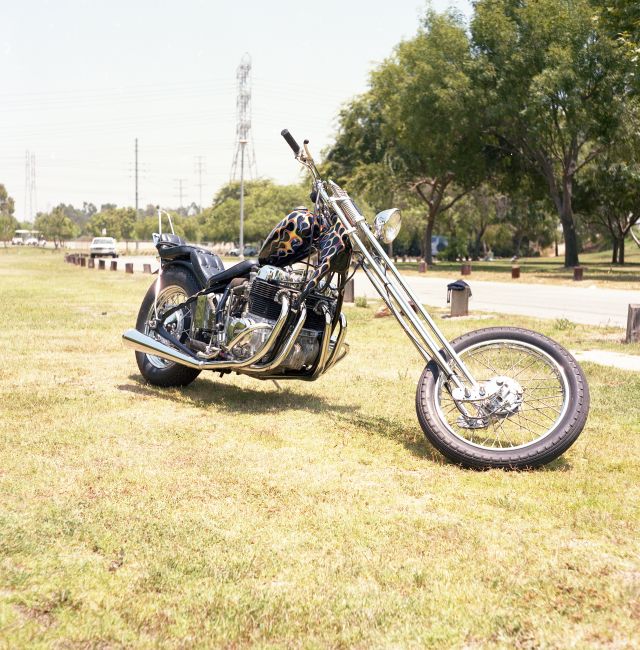
|

|
I also prepared for the ride by doing longer tours on Saturdays. I'd get up early and head north to Morro Bay, about 250 miles one-way, look at the big rock in the bay, and then ride home. It's a long time in the saddle, but helped prepare me for the many days in a row I would be doing the same on this trip. For the month of June, I made my plans, did work on the bike, and rounded up camping gear such as a tent, a sleeping bag, a stove, and a traveling tool kit. I got out my Rand McNally Road Atlas and made a sort of bucket list of places I wanted to see:
- Yosemite National Park
- The Great Salt Lake
- Yellowstone National Park
- Ride the Beartooth Highway
- See Mount Rushmore
- Stop at my sister's in Minnesota for some water skiing
- The Ford Museum and Greenfield Village in Detroit
- North shore of Lake Erie to Toronto
- Watertown, NY
- Into the American South
- Carlsbad Caverns
I marked those locations on my map and planned to go to each one and figure out the route between each while on the road. I gave my girlfriend, who I lived with, my half of the rent and expenses for the next couple months and I was set to go.
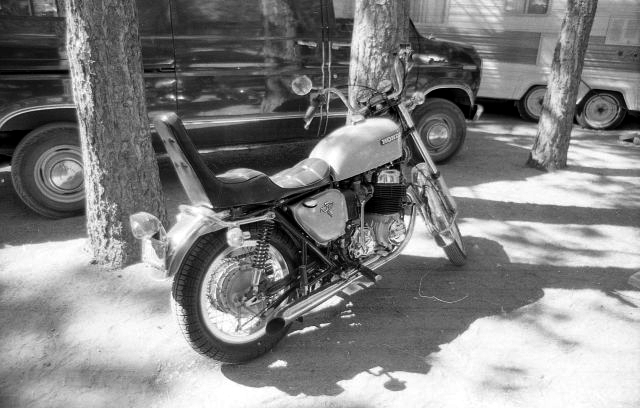 I left about the 1st of July and rode up to June Lake where my parents were staying in their RV. I was there a day or two before I met up with my cousin, Tony, and his friend who were traveling in a VW van over to Yosemite.
I left about the 1st of July and rode up to June Lake where my parents were staying in their RV. I was there a day or two before I met up with my cousin, Tony, and his friend who were traveling in a VW van over to Yosemite. 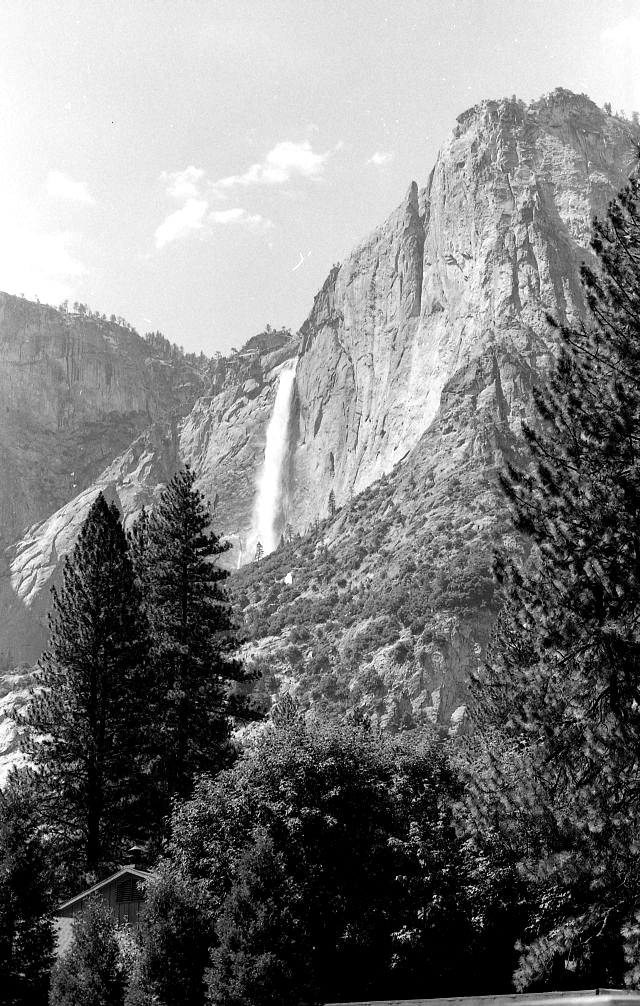 We saw the sights in the valley and then camped and did some hiking in the upper, eastern part of the park. It was fun and I hadn't camped with Tony since we were kids when our families used to do that together. Yosemite is beautiful, but even back then in 1979, it was crowded in the Valley. RVs were everywhere and I felt like a target on a motorcycle as their drivers tried to navigate the narrow, curvy roads while sightseeing at the same time. It was just too much which is why we decided to camp at Tuolumne Meadows where the crowds were not so intense.
We saw the sights in the valley and then camped and did some hiking in the upper, eastern part of the park. It was fun and I hadn't camped with Tony since we were kids when our families used to do that together. Yosemite is beautiful, but even back then in 1979, it was crowded in the Valley. RVs were everywhere and I felt like a target on a motorcycle as their drivers tried to navigate the narrow, curvy roads while sightseeing at the same time. It was just too much which is why we decided to camp at Tuolumne Meadows where the crowds were not so intense.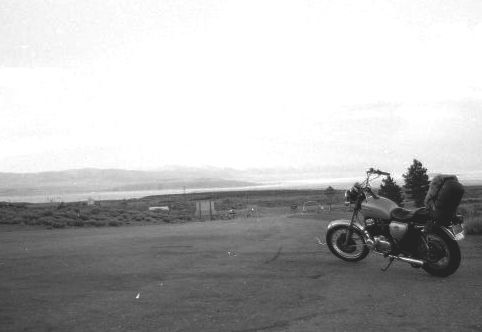
When it was time to head out solo, I said goodbye to Tony and his friend and went east out of the park, down the mountain road, to Lee Vining which is across from Mono Lake. That put me on Highway 395 which I took north into Nevada and into the area around Reno where I found a place to camp for the night.
The following day I did one of my longest rides, from Reno, past the Great Salt Lake, to Ogden, Utah, about 550 miles. That was one long stretch. Although I generally liked to stick to the 2-lane roads, for this portion of the journey I rode Interstate 80 because there weren't really any 2-lanes that went that same direction without lots of zigzagging. Also, it is fairly desolate in that part of the world and, while I had a high level of confidence in my motorcycle, I was still feeling my way regarding being solo on a trip of this length.
When I arrived in Ogden it was nearly dark and I decided to get a motel for the night, the first of only two motel stops I made on the whole trip. I realized that I was pretty wind deaf when the desk clerk kept having to repeat herself to be heard. My bike didn't have a fairing and even though I wore a helmet, that wind noise blasting by for that many hours takes its toll. Before I hit the road the next day, I stopped at a drug store and picked up some ear plugs.
I headed north out of Ogden with my sights set on Yellowstone Park. I had decided that I would enter the park through the south entrance which meant that I would head north to Logan and wind my way toward Jackson, WY, past the Grand Tetons, into Yellowstone. The scenery was spectacular. Even though it was tourist season, this long stretched of two-lane highway was relatively empty of traffic. Around every curve was a breadth of scenery that was right out of a John Ford western. I halfway expected to see Randolph Scott on his horse plodding through one of the meadows.
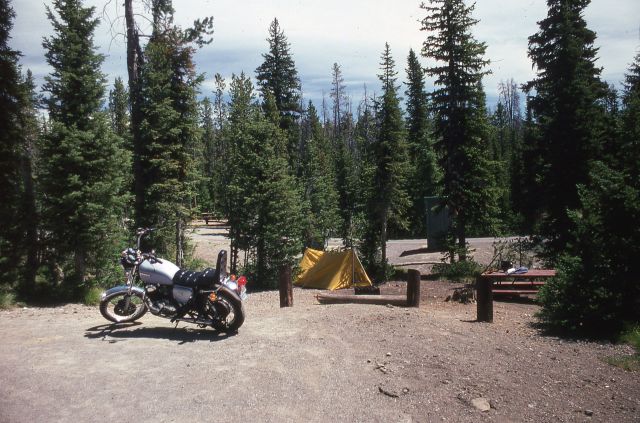 When I arrived at Yellowstone Park I was informed that the only place I could camp, since I didn't have a "hard-sided vehicle," was the Lewis Lake campground. Apparently bear activity made tents in the other parts of the park unsafe. I found my camp spot, parked the bike, and pulled off my helmet. I was greeted by a swarm of hungry mosquitoes. I pulled the helmet back on and rode to the store at Grant Village and bought a can of spray. This made camping quite tolerable.
When I arrived at Yellowstone Park I was informed that the only place I could camp, since I didn't have a "hard-sided vehicle," was the Lewis Lake campground. Apparently bear activity made tents in the other parts of the park unsafe. I found my camp spot, parked the bike, and pulled off my helmet. I was greeted by a swarm of hungry mosquitoes. I pulled the helmet back on and rode to the store at Grant Village and bought a can of spray. This made camping quite tolerable.
 Over the next couple days I took in the sights, which in Yellowstone are many. The geothermal features are the main attraction, and they are everywhere. There are bubbling pools of water and mud, a variety of colors due to minerals and algae and, of course, Old Faithful. While the sights are great, driving through the park wasn't. The roads have a continual series of natural speed bumps, possibly from tree roots under the surface or the result of the freeze/thaw cycle in their winters. It was a bumpy ride.
Over the next couple days I took in the sights, which in Yellowstone are many. The geothermal features are the main attraction, and they are everywhere. There are bubbling pools of water and mud, a variety of colors due to minerals and algae and, of course, Old Faithful. While the sights are great, driving through the park wasn't. The roads have a continual series of natural speed bumps, possibly from tree roots under the surface or the result of the freeze/thaw cycle in their winters. It was a bumpy ride.
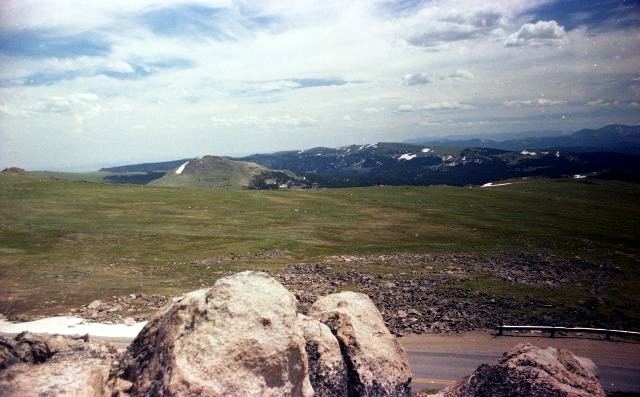 When I made my exit from the park I went north to Tower Junction until I turned onto Highway 212 which took me to the Lamar Valley area of the park, a most beautiful vista. The road eventually exited the park and became the Beartooth Highway, the 60-some miles of which CBS travel reporter Charles Kuralt listed as America Most Beautiful Drive. It would be a claim that is difficult to dispute. It curves, it follows streams, it climbs, the views are nothing short of spectacular, peaking at 10,947 feet. And, above the timber line there are no trees blocking the view of snowcapped peaks and mountain lakes.
When I made my exit from the park I went north to Tower Junction until I turned onto Highway 212 which took me to the Lamar Valley area of the park, a most beautiful vista. The road eventually exited the park and became the Beartooth Highway, the 60-some miles of which CBS travel reporter Charles Kuralt listed as America Most Beautiful Drive. It would be a claim that is difficult to dispute. It curves, it follows streams, it climbs, the views are nothing short of spectacular, peaking at 10,947 feet. And, above the timber line there are no trees blocking the view of snowcapped peaks and mountain lakes.
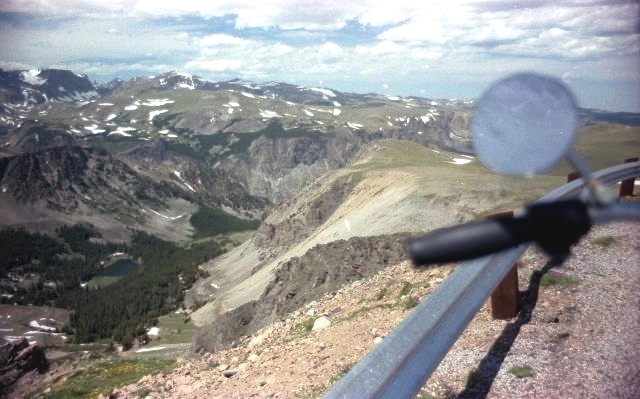
|

|

|
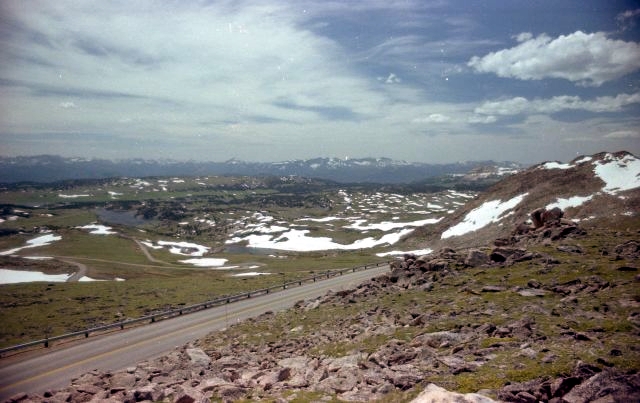
|
Highway 212 drops out the mountains into the tourist and ski town of Red Lodge, MT before continuing northeast to the town of Laurel and the intersection with Interstate 90. This was a bit of a culture shock after a couple days in Yellowstone Park, but it also felt good to be out on the highway just riding again. I hopped on the interstate and rode the 15 or so miles to Billings for gas. I remember looking around at the setting and seeing this city nestled in a valley, bounded by rimrocks on the north, the Yellowstone River to the east and smaller mountains to the south and thinking, "This looks like a pretty cool place." Nowhere in my imagination did I think I would be moving here 12 years later, which I did.
 I stayed on Interstate 90 and found my way to the Black Hills near Rapid City, South Dakota and found camping near Mount Rushmore. It was late in the day and I was ready to pitch my tent and get some rest so a visit to the sculpture would have to wait until the following day.
I stayed on Interstate 90 and found my way to the Black Hills near Rapid City, South Dakota and found camping near Mount Rushmore. It was late in the day and I was ready to pitch my tent and get some rest so a visit to the sculpture would have to wait until the following day.
It is hard to describe that carving and photos really can't express the scale of it set against the surrounding forest. The visitor center does a good job of explaining the history of the project and the facilities make for a good place to take a break.
But the road beckoned. Somewhere before leaving that area I met a couple on their Harley and after chatting a bit and discovering that we were both heading east, we decided to ride together as far as central Minnesota where I would be turning north, and they would be continuing east to just outside Detroit. They were great folks, him in his 50s and she in her early 30s. We took Interstate 90 east and got to somewhere west of Sioux Falls when we pulled over and looked at the weather. It was ominous with heavy black clouds chasing us from the west and a strong tail wind giving us a hard push. We decided to look for a campground and found one a bit further down the road. No sooner had we pitched our tents than the sky open up with a full show of lightning, thunder, and a strong downpour. I stayed pretty dry in my tent and once the storm passed, we got out of our tents and cooked our dinners, had some great conversation, and called it a night.
The next day's ride took us through the rest of South Dakota and into Minnesota. When we got to Blue Earth and Highway 169, we said our goodbyes and I headed north toward Mankato. The drive was great with a flat, 2-lane highway with gentle curves that traveled past farm after farm, following the Minnesota River to the Twin Cities. My sister lived in St. Paul and, somehow, I found my way to her house where I ended up staying for about a week.
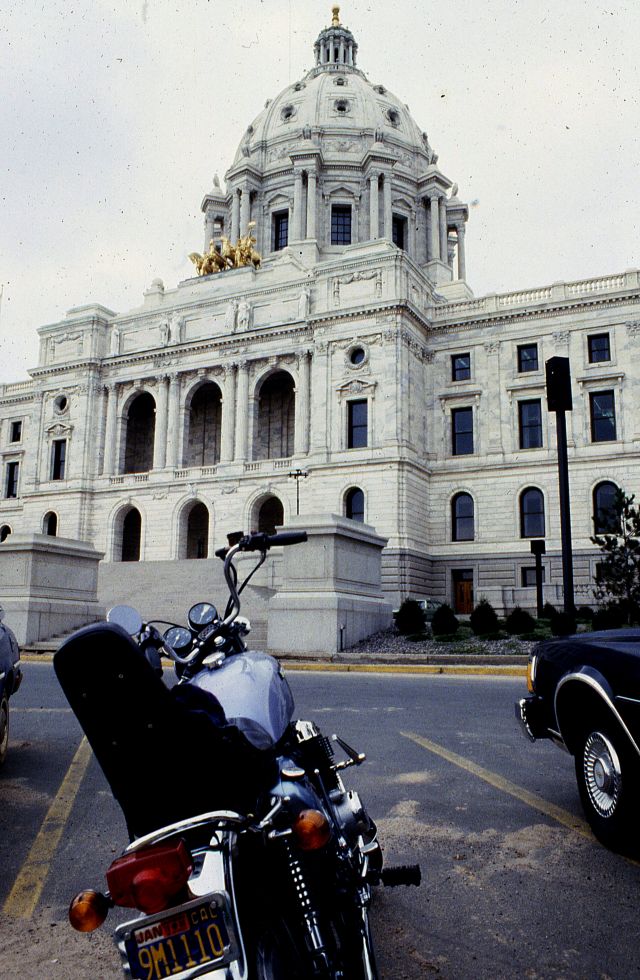 My time there was lots of fun. We did the sights such as their science museum, the capitol, and other attractions in that city. But the real fun was going water skiing. There was a lake nearby named Bald Eagle that was perfect for her little boat and it seemed like we were out there every other day. We'd load up the two gas cans, hook up the boat trailer to her Blazer, and, usually, pick up a friend along the way. We'd get out to the lake and ski until we had run through most of the gas and the sacks we'd taken along. Somedays we'd ski with John who was a super-skier and knew how to do all kinds of tricks. Other days we'd ski with her friend, Sarah, who I married about 15 years later.
My time there was lots of fun. We did the sights such as their science museum, the capitol, and other attractions in that city. But the real fun was going water skiing. There was a lake nearby named Bald Eagle that was perfect for her little boat and it seemed like we were out there every other day. We'd load up the two gas cans, hook up the boat trailer to her Blazer, and, usually, pick up a friend along the way. We'd get out to the lake and ski until we had run through most of the gas and the sacks we'd taken along. Somedays we'd ski with John who was a super-skier and knew how to do all kinds of tricks. Other days we'd ski with her friend, Sarah, who I married about 15 years later.
 On the weekend we trailered the boat to the St. Croix River with some other folks and motored up the river a bit until we found an suitable island to camp on. The days were filled with skiing, floating on the river, playing with the dogs, and just hanging out at the campsite where we'd buried our beer keg to keep it cool.
On the weekend we trailered the boat to the St. Croix River with some other folks and motored up the river a bit until we found an suitable island to camp on. The days were filled with skiing, floating on the river, playing with the dogs, and just hanging out at the campsite where we'd buried our beer keg to keep it cool.
As much fun as I was having, it was time to get back on the road. I wasn't on a schedule or holding to a timeline but there were places I wanted to go, and the reality was that, since I was unemployed, I would run out of funds at some point and needed to get back and find a job.
I headed east out of the Twin Cities and across Wisconsin. My next sight-seeing stop was Detroit and looking at my map indicated that the route took me through Chicago around the southern part of Lake Michigan. The state maps showed a ferry that went across the lake from Milwaukee to Muskegon and I thought that might be a pretty cool thing to add to this adventure. Somewhere along the way, probably a visitor center or rest stop, I found a brochure and saw the price of that shortcut. No, thanks. I don't remember the price, but I did a quick calculation and that fee would buy me the gas I needed for the rest of my trip. I headed to Chicago.
Making my way through Chicago traffic was not as unnerving as it might be for someone else considering that I'd been riding the freeways of Southern California for a few years, but it's pretty safe to say that my lack of photographs from that part of the ride indicates that I just kept my mind on the road, rounded the lake, made it through a bit of Indiana, before arriving in the Detroit area, pretty much non-stop. My plan was to stay a couple nights so I would have one full day at the Ford Museum and Greenfield Village so stopped short of the big city and got a campsite at the KOA which was, more or less, in Ypsilanti. It was a nice place and did have a camping feel to it even though it was just outside a major metropolitan area. I pitched my tent and got ready for the next day's sightseeing.

 I had read about the Henry Ford Museum and Greenfield Village in "The People's Almanac", a book chocked full of trivia, that listed these sites as "must sees." I rode my bike over to the Ford Museum and spent a few hours touring the 150-acre building that displayed the history of technology, primarily that related to transportation. Planes, cars, motorcycles, it had it all. It contains all kinds of American trivia such as the limousine that President Kennedy was riding in on that fateful day in Dallas and the chair that Lincoln was sitting in at the Ford Theater, both a little morbid but certainly historical. There were lots of other items that, if not placed here, would probably be in the Smithsonian.
I had read about the Henry Ford Museum and Greenfield Village in "The People's Almanac", a book chocked full of trivia, that listed these sites as "must sees." I rode my bike over to the Ford Museum and spent a few hours touring the 150-acre building that displayed the history of technology, primarily that related to transportation. Planes, cars, motorcycles, it had it all. It contains all kinds of American trivia such as the limousine that President Kennedy was riding in on that fateful day in Dallas and the chair that Lincoln was sitting in at the Ford Theater, both a little morbid but certainly historical. There were lots of other items that, if not placed here, would probably be in the Smithsonian.
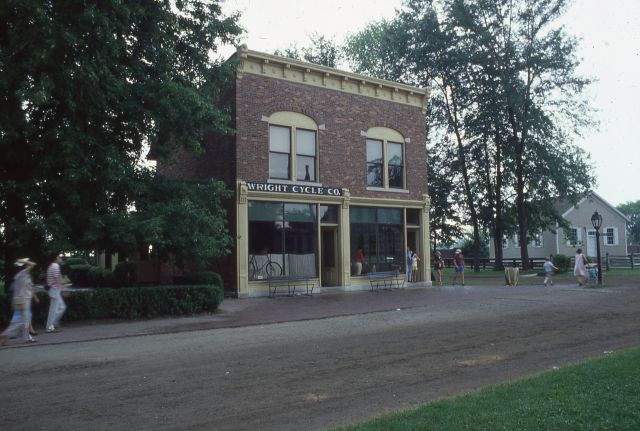 Conveniently, Greenfield Village is located next door. It is a place that Henry Ford established as an outdoor museum in 1929 and contains about 100 historical buildings that Ford had disassembled and reassembled on this site. These structures include the Wright Brothers bicycle shop moved from Dayton, Ohio and Henry Ford's birthplace home. There is also a replica, built from original plans, of Thomas Edison's workshop from Menlo Park, NJ. The museum has working trades shops such as blacksmiths, a steam locomotive train operating on a track around the park, and numerous other antiquities. It was well-worth the visit.
Conveniently, Greenfield Village is located next door. It is a place that Henry Ford established as an outdoor museum in 1929 and contains about 100 historical buildings that Ford had disassembled and reassembled on this site. These structures include the Wright Brothers bicycle shop moved from Dayton, Ohio and Henry Ford's birthplace home. There is also a replica, built from original plans, of Thomas Edison's workshop from Menlo Park, NJ. The museum has working trades shops such as blacksmiths, a steam locomotive train operating on a track around the park, and numerous other antiquities. It was well-worth the visit.
The next morning I decided to head into Canada and follow a northern route above both Lake Erie and Lake Ontario on my way to upstate New York. To get across the border there are a few choices, but I thought that the Detroit-Windsor Tunnel that went under the Detroit River sounded the most interesting and made my way through downtown Detroit to that border crossing. Upon arriving on the Windsor side, I waited my turn at the Canadian Border Services Agency. When they came to me, the agent asked the usual questions about where I was from, where I was going, and so forth. He asked to look through my backpack and didn't seem interested in anything until he pulled a wooden block out of the side pocket. He looked at it closely, turning it over and over and finally asked what it was. I explained that in really warm weather, asphalt becomes soft and it is not uncommon for a motorcycle's kickstand to sink into it when parked. Since I had extended the forks on my bike and hadn't extended the kickstand, my bike leaned as a sharper angle than normal making that problem worse, so I would put the block of wood on the ground and set the kickstand on that. I pointed to the oil stain on both side of the block as evidence that this was what it was used for. He was skeptical and decided to take the block inside for one thing or another and after a bit, came back with it. Still skeptical he handed it back said I was OK to go. I offered to leave the block behind and said I could easily find a replacement somewhere, but he politely told me that wasn't necessary and sent me on my way.
The ride to Toronto was great. I'd been to this region of Canada before when I was stationed at Camp Drum, NY in 1973 and always appreciated the quality of the roads, the lack of litter, and the friendliness of drivers when in this country. The weather continued to be perfect and I just spent the day riding, past Toronto and Kingston until I arrived at the Thousand Island Bridge that took me across the St. Lawrence River and into New York. The crossing there was uneventful, and I was pretty much just waved through. It had been a long day and I felt the need for a rest and a shower, so I found a motel north of Watertown and got a room for the night, my second and last motel stop on the trip.
The next morning I drove past Camp Drum for old time's sake, and then found a pay phone to make a call. I had some unfinished business in that area that I felt I needed to take care of and to get some closure on. I won't be going into that here but things worked out and I left a couple days later and headed south to Pennsylvania.
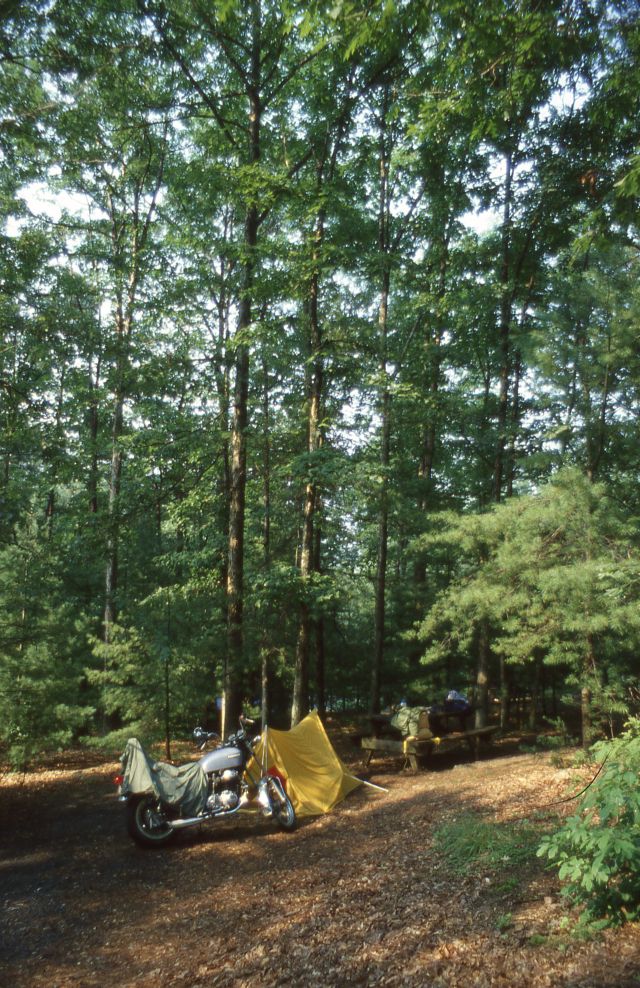 The next segment of the trip was all about riding and thinking. I only had one more bucket list stop to make and that was Carlsbad Caverns in New Mexico, about 2,100 miles from where I was if I took a southern route, a good 4-5 days of riding. I continued south through Pennsylvania and found a campsite somewhere in the eastern part of that state, getting my tent set up just before a huge thunderstorm arrived. I'd been pretty fortunate on this trip regarding the weather. I'd had that storm back in South Dakota and somewhere along the way I'd parked under a bridge in the middle of the day while another storm passed over, but other than that, it had been perfect riding weather. This one was a real gusher. Even though I'd trenched around my tent, it simply wasn't enough to keep the water out. By morning everything inside was pretty wet. As soon as the sun came out, I draped things over the bike, hoping they'd dry out a bit before I had to repack them.
The next segment of the trip was all about riding and thinking. I only had one more bucket list stop to make and that was Carlsbad Caverns in New Mexico, about 2,100 miles from where I was if I took a southern route, a good 4-5 days of riding. I continued south through Pennsylvania and found a campsite somewhere in the eastern part of that state, getting my tent set up just before a huge thunderstorm arrived. I'd been pretty fortunate on this trip regarding the weather. I'd had that storm back in South Dakota and somewhere along the way I'd parked under a bridge in the middle of the day while another storm passed over, but other than that, it had been perfect riding weather. This one was a real gusher. Even though I'd trenched around my tent, it simply wasn't enough to keep the water out. By morning everything inside was pretty wet. As soon as the sun came out, I draped things over the bike, hoping they'd dry out a bit before I had to repack them.
The ride eventually turned west and it felt like I was heading home. I remember going through Shreveport, LA and it felt quite humid. At the end of one of those days I found myself in Dallas, TX, pretty close to their Six Flags amusement park. It was late and I was tired so the attraction held no interest so I found a little park that seemed inviting and pitch camp for the night.
 The next day took me through western Texas and into New Mexico where I worked my way to a campground just outside Carlsbad Caverns. This was definitely the desert. Flat, some rugged outcroppings, warm, and beautiful. I got my camping spot set up and settled in for the night with a plan to be the first one in when the caverns opened in the morning. And I was. Not long after sunrise I got my day started, ate, packed up everything and headed to the visitor center, leaving my bike parked out front. The experience was better than I had anticipated. I descended through the mouth of the cave and walked for quite a way downhill before arriving at the intersection of various self-guided tours. I spent a good long time there, following the routes that the park service had designed, taking it all in, and taking no pictures. I just wanted to experience the moment and not be encumbered by trying to photograph it.
The next day took me through western Texas and into New Mexico where I worked my way to a campground just outside Carlsbad Caverns. This was definitely the desert. Flat, some rugged outcroppings, warm, and beautiful. I got my camping spot set up and settled in for the night with a plan to be the first one in when the caverns opened in the morning. And I was. Not long after sunrise I got my day started, ate, packed up everything and headed to the visitor center, leaving my bike parked out front. The experience was better than I had anticipated. I descended through the mouth of the cave and walked for quite a way downhill before arriving at the intersection of various self-guided tours. I spent a good long time there, following the routes that the park service had designed, taking it all in, and taking no pictures. I just wanted to experience the moment and not be encumbered by trying to photograph it.
When I was ready to leave, I took the elevator back to the surface, waited for my eyes to get reaccustomed to the desert sun, and fired up the bike for the final leg of the journey. I was a few miles south of the caverns, heading southwest on a road that would take me into Texas again and through El Paso when I came upon a burned-out cafe at the side of the road. It looked like the prefect photo opportunity and, since I was probably not going to take many photos between here and the end of the ride, I shot quite few, finishing off a roll of Ektachrome slide film that was in the camera.
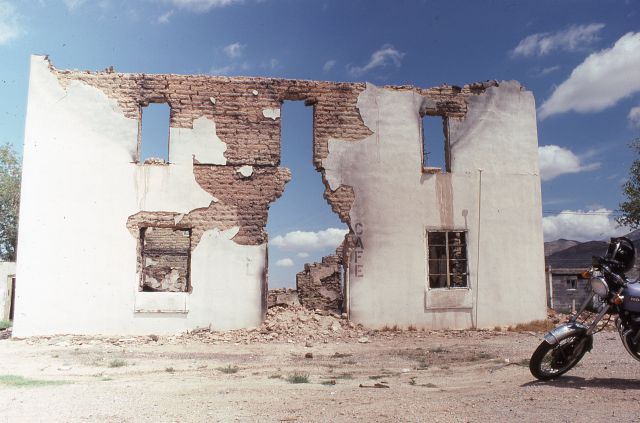
|

|
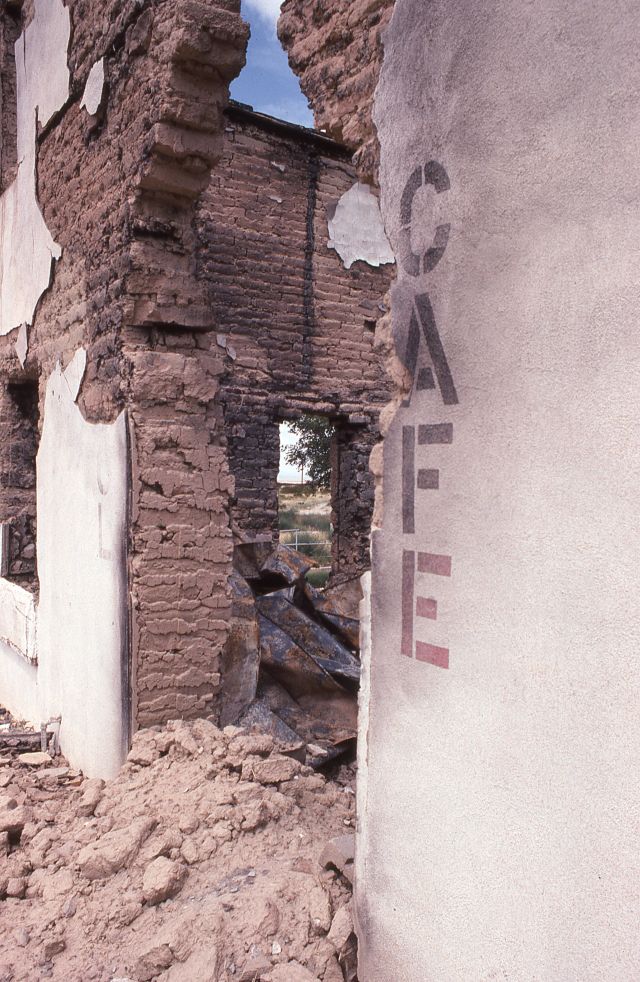
|

|
From there it was a straight shot back to Southern California, about 800 miles. I have little recollection regarding the details of that stretch, but I know I felt a deep level of satisfaction that the trip that had gone very well and I had a sense of personal accomplishment that I'd pulled it off after the many years of just thinking about it.
With about 7,000 miles behind me, I headed back in to Southern California, not unaware of what might be ahead of me at that point in my life. Schooling, for now, was done and I needed to find a job as my funds were heading into the non-existent level. But that, like this trip, is just part of life's adventures and I have certainly learned to look forward to and embrace them.
Go back to the Honda 750 page
Click on an image to enlarge it.
Updated February 2021.